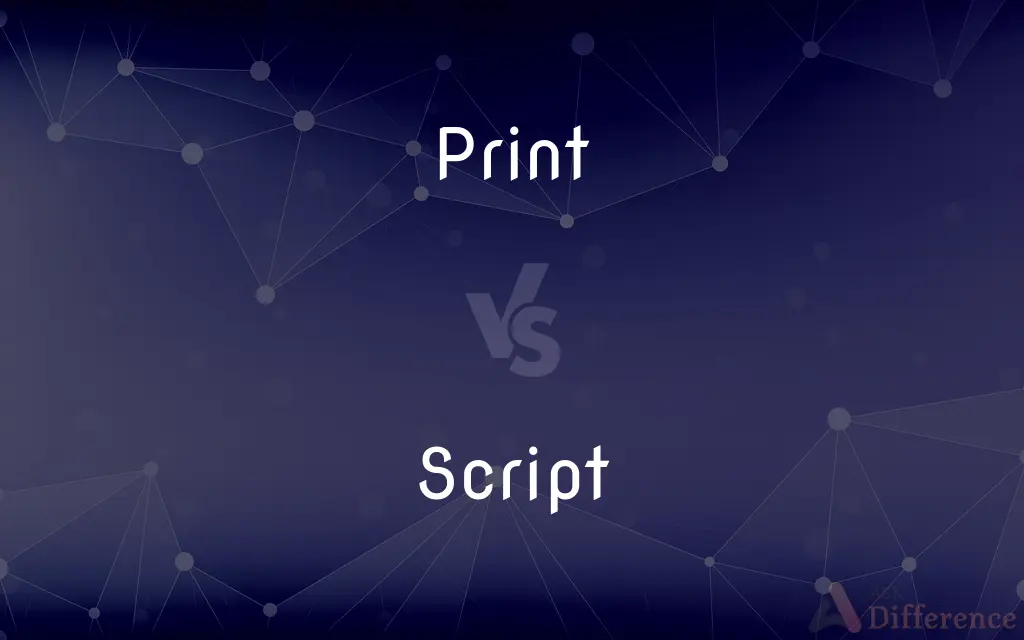Print vs. Script — What's the Difference?
By Maham Liaqat & Fiza Rafique — Updated on April 24, 2024
Print refers to block letters written separately, often used in formal writing and typing, whereas script denotes cursive writing where letters are connected, commonly used for speed and fluidity in handwriting.

Difference Between Print and Script
Table of Contents
ADVERTISEMENT
Key Differences
Print writing is characterized by its clarity and distinct separation of each letter, which makes it particularly suitable for official documents and educational materials. Whereas script writing, with its flowing connections between letters, is often favored for personal notes and creative writing.
Learning to write in print is generally the first step in educational systems, as it helps in letter recognition and is easier for young learners to master. On the other hand, script writing is introduced later and can enhance fine motor skills and writing speed.
In terms of readability, print is usually easier to read, especially for those unfamiliar with a writer's handwriting. Conversely, script can vary greatly in legibility depending on the individual's style, sometimes making it difficult to decipher.
Print style is dominant in most typed documents and is considered the standard in professional communication. In contrast, script remains largely confined to personal handwriting and artistic purposes, reflecting a more personal touch.
While digital communication predominantly uses print due to its universal readability, script has found a niche in digital forms through fonts that mimic handwriting, used to add a personal or artistic flair to electronic communications.
ADVERTISEMENT
Comparison Chart
Characteristics
Block letters, separate
Cursive, connected letters
Common Uses
Official documents, typing, educational materials
Personal notes, creative writing
Readability
High readability, clear separation of characters
Varies, can be hard to read depending on style
Learning Stage
First learned in education
Introduced after mastering print
Digital Use
Standard in digital text and professional documents
Used in special fonts to mimic handwriting
Compare with Definitions
Dominant in digital communications and printed materials.
All emails are written in print.
Script
Often used for personal letters and artistic projects.
He enjoys writing poetry in script for its aesthetic appeal.
A method of writing in which each letter is written separately.
Children first learn to write in print.
Script
A style of writing where letters are connected in a flowing manner.
Her invitation cards were beautifully written in script.
Preferred in educational settings for teaching basic literacy.
Early reading books are written in print.
Script
Reflects a personal touch and uniqueness in writing.
She signed her name in a distinctive script.
Associated with professional and standardized presentations.
The sign was created using a bold print font.
Script
Sometimes used in digital formats through special fonts.
The wedding announcement used a cursive script font.
Often used in formal and official written communications.
The document was typed in clear print for readability.
Script
Can be challenging to read if the handwriting is overly stylized.
The old letter was written in an elaborate script.
Produce (books, newspapers, etc.), especially in large quantities, by a mechanical process involving the transfer of text or designs to paper
A thousand copies of the book were printed
Script
Handwriting.
Write (text) clearly without joining the letters together
Print your name and address on the back of the cheque
Script
A style of writing with cursive characters.
Mark (a surface, typically a fabric or garment) with a coloured design or pattern
A delicate fabric printed with roses
Script
A particular system of writing
Cuneiform script.
The text appearing in a book, newspaper, or other printed publication, especially with reference to its size, form, or style
Bold print
She forced herself to concentrate on the tiny print
Script
A style of type that imitates handwriting.
An indentation or mark made on a surface or soft substance
There were paw prints everywhere
Script
The matter set in this type.
A picture or design printed from a block or plate or copied from a painting by photography
The walls were hung with sporting prints
Script
The text of a play, broadcast, or movie.
A piece of fabric or clothing with a coloured pattern or design printed on it
Light summer prints
A floral print dress
Script
A copy of a text used by a director or performer.
A mark or impression made in or on a surface by pressure
The print of footsteps in the sand.
Script
(Law) The original of a legal instrument, as opposed to a copy.
A fingerprint.
Script
(Computers) A simple program in a language that the computer must convert to machine language each time the program is run.
A device or implement, such as a stamp, die, or seal, used to press markings onto or into a surface
Fancy letters made by hand-carved prints.
Script
To prepare (a text) for filming or broadcasting.
Something formed or marked by such a device.
Script
To arrange, direct, or control (an event or a person) as if supplying a script
"the brilliant, charming, judicial moderate scripted by his White House fans" (Ellen Goodman).
Text, lettering, or other marks produced in ink from type as by a printing press or from digital fonts by an electronic printer
Needed glasses to read the print.
Script
(Computers) To write (code) for a program.
Printed state or form
A short story that never got into print.
Script
A writing; a written document.
A printed publication or edition of a text; a printing
The first print of that book has sold out.
Script
Written characters; style of writing.
A design or picture transferred from an engraved plate, wood block, lithographic stone, or other medium
Had prints of flowers hanging on the walls.
Script
(typography) Type made in imitation of handwriting.
A photographic image transferred to paper or a similar surface.
Script
An original instrument or document.
A copy of a movie made on film or in a high resolution digital format, as for public exhibition.
Script
(countable) The written document containing the dialogue and action for a drama; the text of a stage play, movie, or other performance. Especially, the final form used for the performance itself.
A fabric or garment with a dyed pattern that has been pressed onto it, usually by engraved rollers.
Script
(computing) A file containing a list of user commands, allowing them to be invoked once to execute in sequence.
The pattern itself
A blouse with a paisley print.
Script
(psychology) A behavioral script; sequence of actions in a given situation.
To press (a mark or design, for example) onto or into a surface
Tracks that were printed in the snow.
Script
(linguistics) A system of writing adapted to a particular language or set of languages.
To make an impression on or in (a surface) with a device such as a stamp, seal, or die.
Script
(informal) prescription for drugs or medicine
To press (something, such as a stamp) onto or into a surface to leave a marking.
Script
(transitive) To make or write a script.
To produce by means of pressed type, an electronic printer, or similar means, on a paper surface
Printed more copies of the ad.
Script
(transitive) To devise, concoct, or contrive.
To offer in printed form; publish
The publisher collected the essays and printed them as a book.
Script
A writing; a written document.
To reproduce (a digital document or image) on a paper surface
Printed the email.
Script
Type made in imitation of handwriting.
To convert (a digital document) into a file format designed for publication.
Script
An original instrument or document.
To write (something) in characters similar to those commonly used in print.
Script
Written characters; style of writing.
To impress firmly in the mind or memory
An experience that will be printed in our hearts forever.
Script
A written version of a play or other dramatic composition; used in preparing for a performance
To produce a photographic image from (a negative, for example) by passing light through film onto a photosensitive surface, especially sensitized paper.
Script
Something written by hand;
She recognized his handwriting
His hand was illegible
To produce (an electronic component) by mechanically transferring a circuit or circuit pattern onto a nonconductive surface.
Script
A particular orthography or writing system
To fabricate (an object) by means of a 3D printer.
Script
Write a script for;
The playwright scripted the movie
To work as a printer.
To produce something in printed form by means of a printing press or other reproduction process.
To write characters similar to those commonly used in print.
To produce or receive an impression, marking, or image
The negative printed poorly.
Published or reproduced by printing, especially in contrast to electronic publication
A print newsletter.
Relating to or involved in media based on printing, especially newspapers and magazines
A print journalist.
Of, relating to, or writing for printed publications.
A print edition of a book
(transitive) To produce one or more copies of a text or image on a surface, especially by machine; often used with out or off: print out, print off.
Print the draft double-spaced so we can mark changes between the lines.
To produce a microchip (an integrated circuit) in a process resembling the printing of an image.
The circuitry is printed onto the semiconductor surface.
(ambitransitive) To write very clearly, especially, to write without connecting the letters as in cursive.
Print your name here and sign below.
I'm only in grade 2, so I only know how to print.
(ambitransitive) To publish in a book, newspaper, etc.
How could they print an unfounded rumour like that?
(transitive) To stamp or impress (something) with coloured figures or patterns.
To print calico
(transitive) To fix or impress, as a stamp, mark, character, idea, etc., into or upon something.
(transitive) To stamp something in or upon; to make an impression or mark upon by pressure, or as by pressure.
To display a string on the terminal.
To produce an observable value.
On March 16, 2020, the S&P printed at 2,386.13, one of the worst drops in history.
(transitive) To fingerprint (a person).
(uncountable) Books and other material created by printing presses, considered collectively or as a medium.
Three citations are required for each meaning, including one in print.
TV and the Internet haven't killed print.
(uncountable) Clear handwriting, especially, writing without connected letters as in cursive.
Write in print using block letters.
(uncountable) The letters forming the text of a document.
The print is too small for me to read.
(countable) A newspaper.
A visible impression on a surface.
Using a crayon, the girl made a print of the leaf under the page.
A fingerprint.
Did the police find any prints at the scene?
A footprint.
(visual art) A picture that was created in multiple copies by printing.
(photography) A photograph that has been printed onto paper from the negative.
(film) A copy of a film that can be projected.
Cloth that has had a pattern of dye printed onto it.
(architecture) A plaster cast in bas relief.
To fix or impress, as a stamp, mark, character, idea, etc., into or upon something.
A look will print a thought that never may remove.
Upon his breastplate he beholds a dint,Which in that field young Edward's sword did print.
Perhaps some footsteps printed in the clay.
To stamp something in or upon; to make an impression or mark upon by pressure, or as by pressure.
Forth on his fiery steed betimes he rode,That scarcely prints the turf on which he trod.
To strike off an impression or impressions of, from type, or from stereotype, electrotype, or engraved plates, or the like; in a wider sense, to do the typesetting, presswork, etc., of (a book or other publication); as, to print books, newspapers, pictures; to print an edition of a book.
To stamp or impress with colored figures or patterns; as, to print calico.
To take (a copy, a positive picture, etc.), from a negative, a transparent drawing, or the like, by the action of light upon a sensitized surface.
To use or practice the art of typography; to take impressions of letters, figures, or electrotypes, engraved plates, or the like.
To publish a book or an article.
From the moment he prints, he must except to hear no more truth.
A mark made by impression; a line, character, figure, or indentation, made by the pressure of one thing on another; as, the print of teeth or nails in flesh; the print of the foot in sand or snow.
Where print of human feet was never seen.
A stamp or die for molding or impressing an ornamental design upon an object; as, a butter print.
That which receives an impression, as from a stamp or mold; as, a print of butter.
Printed letters; the impression taken from type, as to excellence, form, size, etc.; as, small print; large print; this line is in print.
That which is produced by printing.
A core print. See under Core.
The result of the printing process;
I want to see it in black and white
A picture or design printed from an engraving
A visible indication made on a surface;
Some previous reader had covered the pages with dozens of marks
Paw prints were everywhere
A copy of a movie on film (especially a particular version of it)
A fabric with a dyed pattern pressed onto it (usually by engraved rollers)
A printed picture produced from a photographic negative
Put into print;
The newspaper published the news of the royal couple's divorce
These news should not be printed
Write as if with print; not cursive
Make into a print;
Print the negative
Reproduce by printing
Common Curiosities
What is the main difference between print and script writing?
Print writing involves separate letters, while script is characterized by connected letters.
Why is print more commonly used in formal documents?
Its clarity and standardization make print more suitable for official and formal communications.
What types of documents are typically written in print?
Official documents, educational materials, and most types of digital communication.
How does script writing enhance personal communications?
Script can convey a personal and artistic touch, making it suitable for invitations and personal notes.
Is script writing becoming less common?
Yes, with the rise of digital communication, script writing is used less frequently.
When is script writing typically taught in schools?
Script writing is usually taught after students have mastered print.
Are there any benefits to learning script writing?
Yes, it can improve fine motor skills and speed in writing.
Why is print writing considered more readable than script?
Print's clear separation of letters enhances readability compared to the variable styles of script.
Can script writing be faster than print?
Yes, script can be faster due to the connected nature of the letters.
Is print used in handwriting as well as typing?
Yes, print is used both in handwritten and typed formats.
Share Your Discovery

Previous Comparison
Micrococcus vs. Staphylococcus
Next Comparison
Promotion vs. DiscountAuthor Spotlight
Written by
Maham LiaqatCo-written by
Fiza RafiqueFiza Rafique is a skilled content writer at AskDifference.com, where she meticulously refines and enhances written pieces. Drawing from her vast editorial expertise, Fiza ensures clarity, accuracy, and precision in every article. Passionate about language, she continually seeks to elevate the quality of content for readers worldwide.
















































